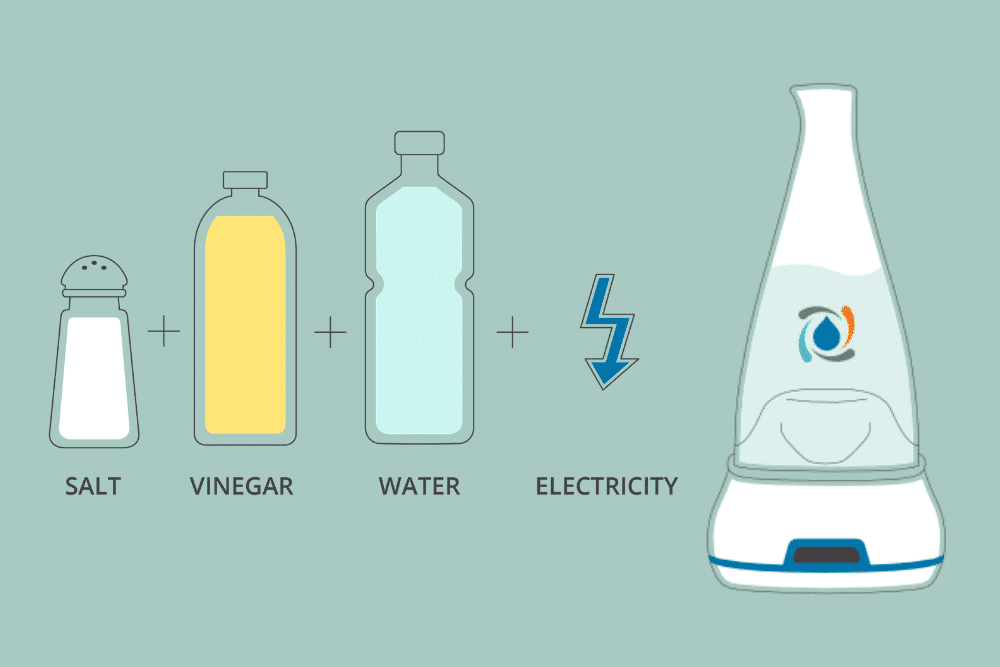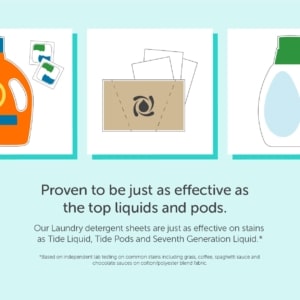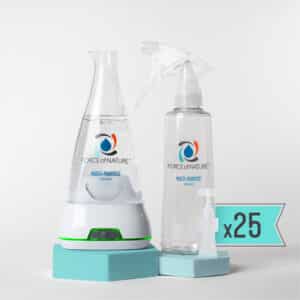
Electro-say what now? A lot of people haven’t heard of electrolyzed water, which makes sense because most people don’t have the space or budget for industrial-size tanks costing $10,000. Electrolyzed water is a pretty simple technology from the industrial space that uses electricity to change the chemical structure of salt, water & vinegar into a cleaner & disinfectant as effective as bleach, but with no harmful chemicals.
What is electrolyzed water?
The principle underlying electrolyzed water is the same as in cooking: combining elements under certain conditions creates a new substance that is very different from its component parts. (Hats off to baking powder for making our cakes taste better than eggs & flour!). That’s why ingredients as basic as salt, water & vinegar can be converted into a cleaner & disinfectant as effective as bleach.
How does the chemistry work?
When Force of Nature passes an electrical charge through the salt (NaCl) solution, the sodium separates from the chloride. Chloride is negatively charged and is attracted to the positive side of the electrical charge where it bonds with oxygen and hydrogen from the water. It gets converted from Cl- to HOCl, otherwise known as hypochlorous acid, the active ingredient in Force of Nature. Hypochlorous acid is so gentle and effective it’s commonly used in wound healing products and other healthcare products. The sodium is positive and is thus attracted to the negative charge, where it also bonds with oxygen and hydrogen and is electrochemically converted to sodium hydroxide or NaOH. The vinegar is the key to getting just the right pH. Without the right pH, you could get a solution that is mostly bleach (sodium hypochlorite). When you lower the pH to exactly the right level, the hypochlorite converts to hypochlorous acid. It’s the hypochlorous acid that makes the solution so gentle compared to cleaning with bleach. And this chemistry used to only happen in industrial size tanks, until Force of Nature miniaturized this technology into a little countertop appliance.
Here’s a little video that explains the chemistry:
Your immune system’s 1st line of defense
Now you know the active ingredient in Force of Nature is hypochlorous acid. But did you know that it’s the same substance your white blood cells produce to fight infection? It’s commonly used products that have to be gentle like these:
- Wound healing (approved by the FDA)
- Eye care (approved by the FDA)
- Veterinary care
- Organic crop production (approved by USDA)
A Detergent Without Bubbles
The other ingredient, at 0.0000003% concentration, is sodium hydroxide. This ingredient is a commonly used detergent in products ranging from skincare to body wash to toothpaste, as well as in all-purpose cleaners. In all-purpose cleaners, typical concentration levels are from 1-5%, which is 3-17 million times the concentration as in Force of Nature. Unlike typical cleaners, Force of Nature is so gentle (see SDS) you can use it to clean things like baby & pet toys without needing to rinse.
Resources to learn more
If you’re reading this, you’re probably interested in ingredient safety. Maybe you’re trying to avoid fragrances, preservatives, surfactants & dyes because of allergies, asthma, MCS, or other health concerns at home or at work, or maybe you have young children at home. Whatever the reason, we hope Force of Nature can provide you with a worry-free cleaning & disinfecting option. It’s an EPA registered disinfectant registered for use in hospitals, ICUs, daycares, schools, veterinary clinics, hotels, gyms and more, and it’s on the EPA’s List of Disinfectants Approved for Use Against SARS-CoV-2, the cause of COVID-19. To help you do some more research on electrolyzed water, here are some sources to check out:
Examples of electrolyzed water in the industrial space
Research:
Disinfecting, use in healthcare, use as a virucide and in sanitizing
Why you won’t find electrolyzed water on a store shelf
The reason is that just like bubbles in a carbonated drink, hypochlorous acid starts to dissipate over time. That means a bottle of electrolyzed water sitting on a store shelf or in a warehouse would lose its efficacy within just a few weeks. That’s why it’s a cleaner you have to make fresh at home.
Learn More
Got questions? We’ve got answers! Learn how Force of Nature compares to top cleaning brands. Or learn more about how electrolyzed water works and how Force of Nature kills viruses. You might be interested to see other hypochorous acid uses too.



